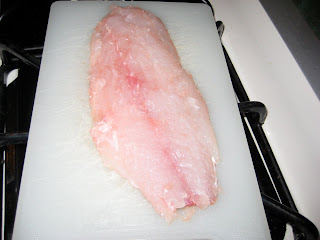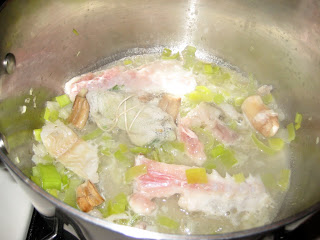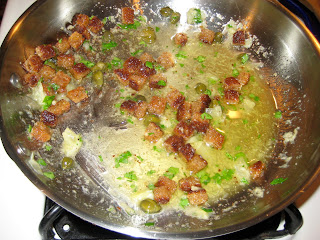Session 15: Working with Fish was quite a challenging experience, yet a very rewarding one, too. I had five Demonstrations.
The first thing I needed to learn was how to clean a fish. We had a boat when I was growing up, so I had seen my dad and grandfather do this thousands of times, but it was a bit different in my little kitchen-- all on my own.
I had trouble finding whole fish in the types needed for the recipes, so after a few hours of searching every food store in the area, I decided it was the technique I needed to be practicing, so I bought a few whole fish that were available (Snapper from the USA) and practiced my filleting skills on those. The fish was very fresh and the clean smell of it took me back to being 8 years old and on the lake, "fishing" with my parents and sisters. I used quotes because I always made my dad throw back whatever I caught, which usually still resulted in the demise of the poor fish.
But, my first fillet looked like this, and by the third fish (6th fillet) and a different knife, I was doing pretty well, so figured I could move on. By the end of this session, I was pretty good.
The first Demonstration I made was Fillet de Sole Bonne Femme (Fillet of Sole with Vegetables). The recipe calls for sole or flounder fillets, and my Whole Foods had a great selection of USA, wild caught flounder from New England, so I went with that. This demo also called for the preparation of fish stock or Fumet, which, you'll remember I postponed from Session Three: Stocks, so I got to make that as well. I made the stock by heating butter in a pan over medium heat and then sautéed onions and leeks in it until they had sweated their liquid but hadn't taken on any color. I added some mushroom trimmings, a bouquet garni, and a bunch of bones I had reserved from my fish butchering practice and added just enough cold water to cover.
Anyway, once the fumet was made, I coated the bottom of a pan with butter, sprinkled it with a mixture of sliced button mushrooms and shallots I had marinating and folded my flounder fillets on top. I added salt and pepper to taste, and then some white wine and the fumet until the liquid came just halfway up the sides of the fish.
The sauce was made by bringing heavy cream to a simmer and then lowering the heat until the liquid had reduced by about a third, and thickened up. This was whisked into the stock/wine mixture in the now fishless pan, which had been brought to a boil for about 10 minutes, until it had been reduced too. The cream/stock mixture was then simmered for a few minutes more, until it was thick enough to coat the back of a spoon (nappant). A bit more heavy cream was whisked in a cold bowl until medium peaks formed, and then this was folded into the sauce.
I put some mashed potatoes in the center of a plate, topped with the fish and mushrooms, and then covered with the sauce. This went into the broiler for a few minutes until the fillets were glazed, sprinkled with fresh herbs, and that was it.
I'm not sure where the "with vegetables" of this dish comes in, but I guess mushrooms count? (I thought they were a fungus?). Either way, this dish was really great -- rich but not fishy, and the wine, cream, and shallots went perfectly with the flounder. It reminded me a bit of the Chicken Fricassee with Spring Vegetables from Session 10.
I skipped over the next three Demonstrations to Goujonettes de Sole aux Deux Sauces (Fried Slices of Sole with Two Sauces) since the recipe called for sole or flounder, which I used in the first recipe. This was a fun recipe, and I instilled the help of my handsome and trusty sous chef: Chris. First, I cut the fillets on the bias into strips that were 2 inches x 3/8 inch, and practiced my breading skills by lightly dipping the pieces in flour first, then a mixture of eggs, peanut oil, and salt, and finally in breadcrumbs -- making sure to tap off any excess at each step. These went into the fridge until I was ready to cook them. In the meantime, I made the tartar sauce (sauce tartare) by making a simple mayo and then adding chopped cornichons, capers, tarragon, parsley and chervil.
The second sauce was a red pepper sauce (sauce au poivrons rouge), which had me sautéeing red bell pepper strips in olive oil over medium heat until they had sweated their liquid. I then added some crushed garlic, a bit of water to moisten the pan, and covered with a parchment round with a hole in the center for about 20 minutes, until the peppers were almost mushy. Then, I put them in a blender and puréed them before running through my trusty chinois. The strained purée then went back on the stove to simmer and then I added some reduced heavy cream until it had a nice saucy consistency. I added some salt/pepper to taste, and that sauce was ready, too.
I heated oil in my deep-fry pan until it reached 365 degrees, and then added the fish pieces (gougonettes) a basket at a time, for just a few minutes, until golden brown. They drained on paper towels, and then in went waffle cut potato slices (gaufrettes), which Chris had sliced for me on the mandoline. (He's much better at it than I am.) And then finally, some parsley sprigs went into the hot oil until crisp and those were drained as well. To plate, I put an equal portion of fish and the chips, garnished with lemon wedges and the fried parsley sprigs, and then served with the tartar sauce and a dash of the red pepper sauce.
This was a really great dish -- and again, there was no strong fish smell in the house. It was a classy take on fish (sticks) and chips, and I especially loved the red pepper sauce. This is a keeper. We made fish tacos with the leftovers, too. I made a quick coleslaw with cabbage, carrots, cilantro from the garden, mayo, sugar, and vinegar and put it in the center of a wheat tortilla (I wanted to make the tortillas from scratch, but didn't have enough time), and then topped it with a few pieces of the fried fish, a dash of the red pepper sauce and a piece of lettuce. Talk about yum.
Next, I went back to the Demonstrations I had skipped and started with Filet de Truite Grenobloise (Trout Fillet with Lemon, Butter, and Parsley Sauce). This was terrific, too. First, I took cubes of bread and sautéed them in 2 TBS of butter until golden brown and then set aside on paper towels to drain. Then, I removed the rind and pith (peler à vif) from a lemon and then cut those suprêmes into 1/2 inch pieces. I seasoned my trout fillets with salt and pepper and lightly dusted with flour. I added to a hot pan of clarified butter (presentation side down) and cooked for about 3 minutes on each side until browned. The fillets went on a warm plate and were tented with aluminum foil. I wiped the pan clean and then added 5 TBS of butter and cooked until it reached the noisette stage (nut-brown in color). Then, in went the diced lemon, capers, parsley and croutons until heated through. This was spooned over the fish and garnished with potatoes and lemon wedges. Ta-da!
After the trout, came Basic Fish Mousseline, which I must admit, I don't think I would ever serve to anyone I like or want to have back for dinner ever again. It was kind of gross fish puff, I think. But, I still had to make it. The recipe didn't specify what kind of fish to use, so I used the snapper from my fish massacre. I puréed it in a food processor until smooth, and then pressed that through a strainer and into a chilled bowl until the texture was extremely smooth. This went into the fridge for about an hour until well chilled. Then, the bowl went over ice and I whisked in an egg white. Once that was mixed in, in went about a cup of heavy cream at small intervals, until creamy and fluffy. The book says to then season with whatever flavorings are required in your recipe -- but I didn't have a recipe beyond this demo, so I added some salt and pepper.
I brought a pan of water to boil, then brought to a simmer and formed the mixture into quenelles (using two spoons), dropping each into the water for about 2-3 minutes, until cooked through. These were pulled from the water and drained. And then, you proceed with whatever step your recipe calls for next (again, no other instruction for this). They were quivery and white and just not my idea of good eating, so I had a bite (they tasted like fish and egg and cream) and then tossed them. After all, the last Demonstration, Poisson en Papillote (Fish Cooked in Parchment) was waiting.
This next dish, I will make again and again. It was easy, yet impressive, and the flavors went beautifully together. I had to improvise with this recipe too (not a good week for fish, apparently), and instead of regular bass fillets, I used sea bass from the Georgia coast -- the fish guy at Whole Foods said it would be terrific, and he was right. After all, the book didn't specify what kind of bass... :)
I had to make a tomato fondue and duxelles for the base of this dish. The tomato fondue, I had made before: heat butter/oil in a pan over medium heat, sweat onions, shallots and garlic for about 5 minutes, then add cored/peeled tomatoes and cover with parchment round (with small hole cut for venting) and cook for about 10 minutes until the liquid has evaporated. The duxelles was made by finely chopping 7 oz. of button mushrooms (soak in water and lemon juice if not nice and white) and then adding to a pan of sweated shallots and some lemon juice and covering with a vented parchment round for about 10 minutes until all the liquid has left the pan. I also julienned leeks, carrots and celery and cooked them à l'étuvé with butter and salt. Then, I assembled the dish.
I took parchment sheets and cut them into large heart shapes (12 h x 18 w) and in the middle, put equal portions of the fondue and the duxelles. Then, on went my bass (they had been brushed with vegetable oil and sprinkled with salt/pepper and chopped thyme from our garden, and the skin was scored to prevent curling) a handful of the julienned garnish, a sprig of thyme and a drizzle of white wine.
I folded the parchment half over this and sealed the edge with egg whites, and then crimped them again for extra security. I think next time, I wouldn't put the fish in the center of the paper, as the book suggests, but instead, off to the side so I have an equal amount of paper to fold over the fish.The parchment packets (papillotes) were brushed with vegetable oil and then went into a 450 degree oven for about 8-10 minutes.
When we opened the packets, a puff of fragrant steam was released and a lovely, colorful dish was presented. It tasted like summer and Chris, who does not usually like mushrooms, was raving about the duxelles. The fish was perfectly cooked -- silky and flaky, but slightly firm, too. The flavors were perfect together -- a bright, light, satisfying dish.
Chris said this was restaurant quality, and I would agree. This was a knockout dish and I can't wait to make it again. So, that's it fishes -- you're safe for now from the Gourmess.
Next is Session 16: Working with Shellfish -- just in time for a quick vacation to the shore!
More soon --we're getting there, folks!!!
xoxoxxo

















